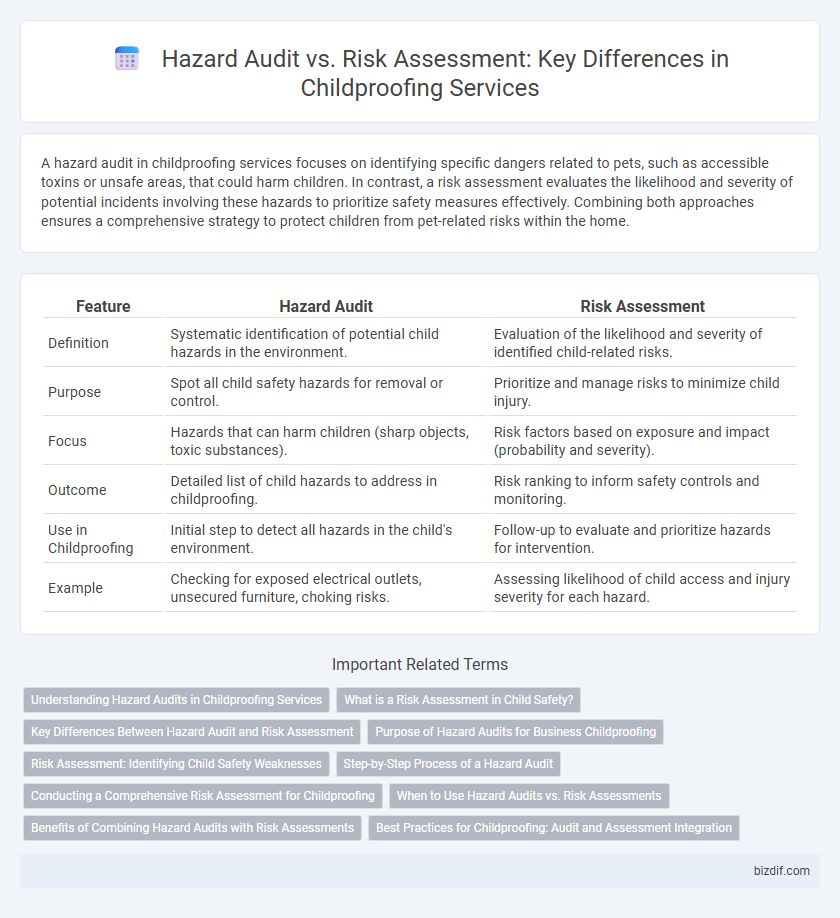A hazard audit in childproofing services focuses on identifying specific dangers related to pets, such as accessible toxins or unsafe areas, that could harm children. In contrast, a risk assessment evaluates the likelihood and severity of potential incidents involving these hazards to prioritize safety measures effectively. Combining both approaches ensures a comprehensive strategy to protect children from pet-related risks within the home.
Table of Comparison
| Feature | Hazard Audit | Risk Assessment |
|---|---|---|
| Definition | Systematic identification of potential child hazards in the environment. | Evaluation of the likelihood and severity of identified child-related risks. |
| Purpose | Spot all child safety hazards for removal or control. | Prioritize and manage risks to minimize child injury. |
| Focus | Hazards that can harm children (sharp objects, toxic substances). | Risk factors based on exposure and impact (probability and severity). |
| Outcome | Detailed list of child hazards to address in childproofing. | Risk ranking to inform safety controls and monitoring. |
| Use in Childproofing | Initial step to detect all hazards in the child's environment. | Follow-up to evaluate and prioritize hazards for intervention. |
| Example | Checking for exposed electrical outlets, unsecured furniture, choking risks. | Assessing likelihood of child access and injury severity for each hazard. |
Understanding Hazard Audits in Childproofing Services
A hazard audit in childproofing services systematically identifies potential dangers within a home environment that could cause injury to children, such as unsecured furniture, exposed electrical outlets, and toxic household items. This process involves a detailed inspection by certified professionals to ensure all possible hazards are recognized and addressed before risks escalate. Understanding the scope and thoroughness of hazard audits allows parents to make informed decisions about protective measures tailored to their child's safety needs.
What is a Risk Assessment in Child Safety?
A Risk Assessment in child safety identifies potential dangers in the home environment, evaluating the likelihood and severity of harm to children. This process systematically analyzes factors such as hazardous objects, toxic substances, and unsafe furniture arrangements to prioritize preventive measures. By addressing these risks proactively, childproofing services effectively reduce accidents and create safer living spaces for children.
Key Differences Between Hazard Audit and Risk Assessment
Hazard audits identify potential dangers in a child's environment by systematically inspecting areas where injuries might occur, focusing on specific hazards such as sharp edges or toxic substances. Risk assessments evaluate the likelihood and severity of harm by analyzing the probability of exposure to identified hazards and the possible consequences for child safety. The key difference lies in hazard audits targeting the presence of hazards, while risk assessments prioritize understanding and mitigating the actual risk levels associated with those hazards to ensure effective childproofing.
Purpose of Hazard Audits for Business Childproofing
Hazard audits in business childproofing focus on systematically identifying potential safety threats within environments frequented by children, ensuring compliance with child safety regulations. These audits aim to detect hazards such as sharp edges, choking risks, and toxic substances to prevent accidents and injuries. The purpose of hazard audits is to create safer spaces by proactively addressing vulnerabilities before incidents occur.
Risk Assessment: Identifying Child Safety Weaknesses
Risk assessment in childproofing is a systematic process that identifies potential hazards and safety weaknesses within a home environment where children live or play. It involves analyzing areas such as electrical outlets, sharp edges, and toxic materials to determine the likelihood and severity of injury, enabling targeted interventions. This thorough evaluation helps prioritize safety measures, ensuring that child safety is optimized through evidence-based solutions.
Step-by-Step Process of a Hazard Audit
A hazard audit in childproofing involves systematically inspecting the home to identify potential dangers such as sharp edges, electrical outlets, and toxic substances. The step-by-step process includes examining every room, checking furniture stability, and assessing access points to ensure safety measures are effective. This detailed inspection helps prioritize childproofing interventions before performing a broader risk assessment that evaluates likelihood and consequences of hazards.
Conducting a Comprehensive Risk Assessment for Childproofing
Conducting a comprehensive risk assessment for childproofing involves identifying potential hazards in the home environment that could pose dangers to children, such as sharp objects, toxic substances, and unsecured furniture. This process evaluates the likelihood and severity of harm, prioritizing areas that require immediate attention to prevent accidents. Unlike a basic hazard audit that only lists potential dangers, a thorough risk assessment provides actionable insights to implement effective childproofing measures tailored to the child's specific environment and developmental stage.
When to Use Hazard Audits vs. Risk Assessments
Hazard audits identify specific dangers in a child's environment, making them ideal for initial childproofing evaluations or after major changes in the home. Risk assessments measure the likelihood and severity of harm from those hazards, guiding prioritization for ongoing safety improvements. Use hazard audits during early stages or post-modification, and risk assessments regularly to maintain and enhance child safety standards.
Benefits of Combining Hazard Audits with Risk Assessments
Combining hazard audits with risk assessments in childproofing services enhances safety by systematically identifying potential dangers and evaluating their likelihood and severity. This integrated approach ensures comprehensive mitigation strategies tailored to a child's environment, reducing accidents more effectively than either method alone. The synergy of both processes promotes proactive safety measures and fosters peace of mind for parents and caregivers.
Best Practices for Childproofing: Audit and Assessment Integration
Hazard audits systematically identify potential dangers in a child's environment, while risk assessments evaluate the likelihood and severity of harm from those hazards. Integrating both practices ensures comprehensive childproofing by combining the identification of all possible hazards with an understanding of their potential impact. Best practices include regularly updating audits and assessments, prioritizing interventions based on risk levels, and involving caregivers in the evaluation process to tailor childproofing measures effectively.
Hazard Audit vs Risk Assessment Infographic

 bizdif.com
bizdif.com